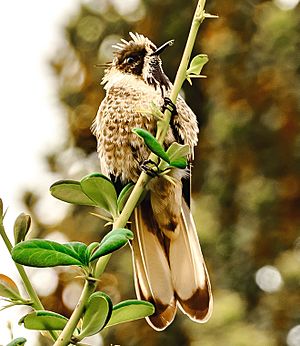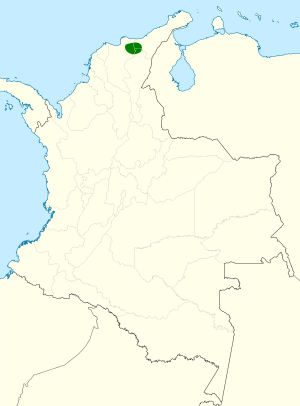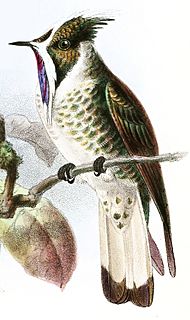Blue-bearded helmetcrest facts for kids
Quick facts for kids Blue-bearded helmetcrest |
|
|---|---|
 |
|
| At Lagos de Sevilla, Santa Marta Mountains, Colombia, photographed by Carole Turek of Hummingbird Spot | |
| Conservation status | |
| Scientific classification | |
| Genus: |
Oxypogon
|
| Species: |
cyanolaemus
|
 |
|
The blue-bearded helmetcrest (Oxypogon cyanolaemus) is a special type of hummingbird. It is known as a "coquette" and is found only in the Sierra Nevada de Santa Marta mountains in northern Colombia. This bird is currently listed as Critically Endangered, meaning it is at a very high risk of disappearing forever.
Contents
About the Blue-bearded Helmetcrest
How it Got its Name
The blue-bearded helmetcrest was once thought to be a part of a larger group called the bearded helmetcrest. But in 2013, scientists studied these birds closely. They looked at their size and the colors of their feathers. Based on this research, they decided that the blue-bearded helmetcrest was unique enough to be its own species. The original bearded helmetcrest was then split into four different species. The one that stayed with the original name is now called the green-bearded helmetcrest. The blue-bearded helmetcrest is a "monotypic" species, which means it does not have any subspecies.
What Does it Look Like?
This hummingbird is about 11.5 centimeters (4.5 inches) long. It has a short, straight beak. Male blue-bearded helmetcrests have a cool black and white crest on their head. Their face is mostly dark, with a light, creamy-white "collar" around their neck. Their upper body feathers are olive green.
The most striking feature of the male is its throat. It has a thin white "beard" with a bright purplish-blue stripe right in the middle. The rest of its underside is a dull, creamy color with olive spots. This fades to a lighter, creamy white under its tail.
Its tail is a medium length and is forked, like a "V" shape. The top side of the middle tail feathers is a bronzy olive color. The other tail feathers are white with reddish-bronze edges and tips. The underside of the tail is cream with wide olive tips.
Female blue-bearded helmetcrests look similar to the males but are a bit duller in color. They do not have the crest on their head or the special beard. Young birds look like the adult females, but they also do not have the white throat.
Where Does it Live?
The blue-bearded helmetcrest lives only in the isolated Sierra Nevada de Santa Marta mountains in northern Colombia. This area is very special because it is a high-altitude region. These birds live in páramo grasslands. Páramo is a type of mountain ecosystem found in the Andes. They can be found at very high elevations, between 3,000 and 4,800 meters (about 9,800 to 15,700 feet) above sea level.
Blue-bearded Helmetcrest Behavior
How Does it Move?
Scientists do not know much about how the blue-bearded helmetcrest moves around. It is not known if they migrate or stay in the same area all year.
What Does it Eat?
Little is known about what the blue-bearded helmetcrest eats or how it finds its food. However, people have seen it feeding on nectar from a few types of flowering plants and shrubs. It can get nectar by hovering in the air in front of the flower or by clinging to the flower itself. Its main food source seems to be a plant called Libanothamnus occultus.
How Does it Breed?
Scientists also do not know much about how the blue-bearded helmetcrest breeds or when its breeding season is.
What Does it Sound Like?
As of early 2022, there were a few recordings of the blue-bearded helmetcrest's sounds. You can find some of these recordings on websites like Xeno-canto and Cornell University's Macaulay Library.
Protecting the Blue-bearded Helmetcrest
The IUCN (International Union for Conservation of Nature) has listed the blue-bearded helmetcrest as Critically Endangered. This means it is facing an extremely high risk of extinction in the wild. There are fewer than 250 adult birds left, and their numbers are believed to be decreasing.
For many years, this bird was thought to be lost. The last time it was officially seen was in 1946. Even after many searches between 1999 and 2011, no one could find the species.
However, in March 2015, something amazing happened! Researchers from the ProAves foundation rediscovered the blue-bearded helmetcrest. They found it while they were studying fires started by local farmers.
Even though the bird's entire home is supposed to be protected within the Sierra Nevada de Santa Marta National Park, there are still challenges. Local Indigenous people sometimes burn the páramo grasslands to create areas for cattle to graze. They also collect Libanothamnus occultus (the bird's main food source) for firewood. These activities can harm the bird's habitat and make it harder for the species to survive. Efforts are being made to protect this unique hummingbird and its mountain home.
See also
 In Spanish: Barbudito azul paramuno para niños
In Spanish: Barbudito azul paramuno para niños



